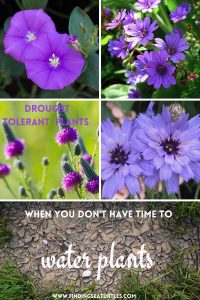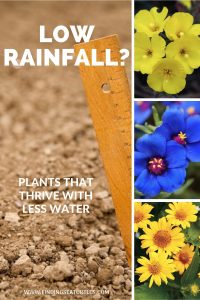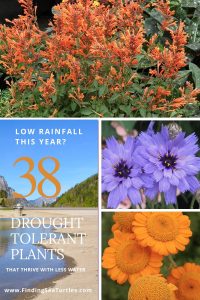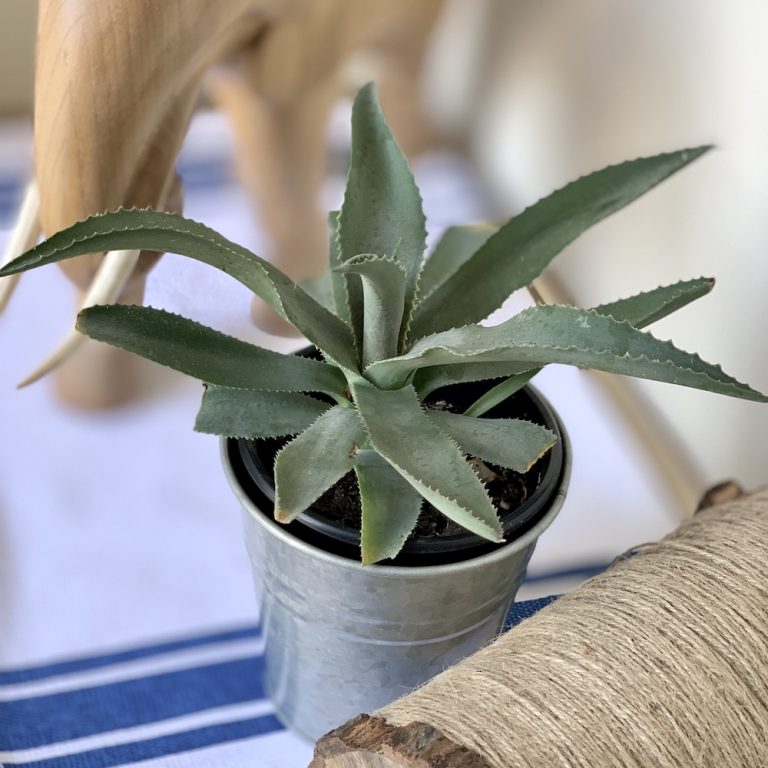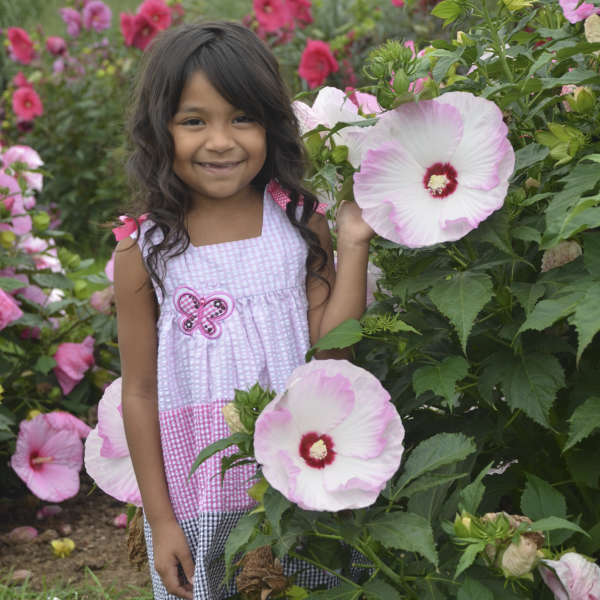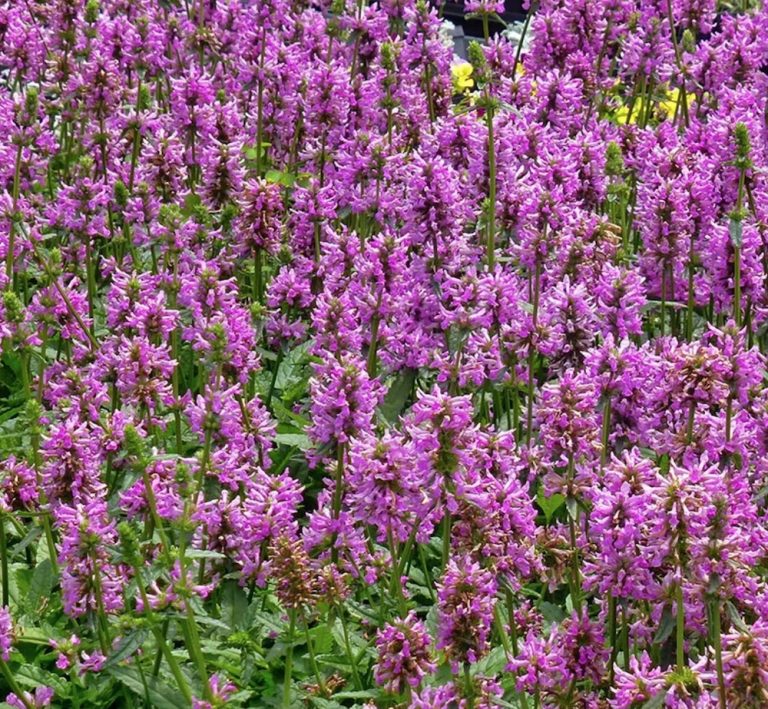Plants that are Drought Tolerant
Plants that are drought tolerant are plants that can withstand periods of little to no water. Although this happens after the plant has been established. Simply digging a hole in the ground and dropping a plant in the hole doesn’t mean you are done. Once in the ground, plants become “established” between a year or two.
Of most importance, is to follow the grower’s plant tag instructions for planting and subsequent plant care. Many growers recommend watering plants twice weekly, from the first through the second year after planting them. Of course, if the perennials receive a fair amount of rainfall in a given week, then skip the watering for that week. Likewise, if there is no rainfall in a given week then continue the twice a week watering. Noted on the plant tab, the instruction indicates the watering frequency once the plant has been established.

Once the plant has become established, then yes these plants can withstand periods of less rainfall or weekly watering. But then again, you might want to fuss over these plants because they are so beautiful.
Take a look at these drought tolerant plants that once established, do just fine with less watering.
Here is our list of drought tolerant plants. You just might see a few plants that you’ll love.
-
Achillea – Plants that are Drought Tolerant
A common name for Achillea is Yarrow. Yarrow is not only tolerant of drought, but equally tolerant of wind, and heat conditions, Another important point, is that Yarrow grows well in many types of soils. Plant Yarrow in a cutting garden, to grow flowers for freshly cut bouquets and dried floral arrangements. And just as important, Achillea is a pollinator favorite.
Achillea m. Saucy Seduction
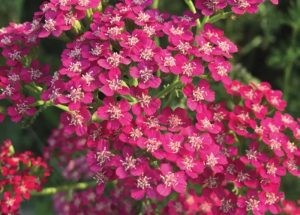
Grows in zones 3 to 8
Full Sun
At maturity, Saucy Seduction reaches 16 to 20 inches tall
Fragrantly scented, pink flowers bloom from Summer into early Fall
Brightly colored blooms are a pollinator favorite
Resistant to both deer and rabbits
Use flowers in cut and dried floral bouquets
Prefers well-draining soil conditions
Plant in containers
Tolerant of drought conditions, once established
Achillea m. Strawberry Seduction
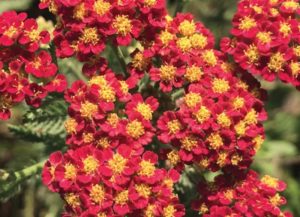
Achillea m. Strawberry Seduction
Grows in zones 3 to 8
Full Sun
At maturity, Strawberry Seduction, tops out between 20 to 24 inches tall
Strawberry red flower clusters with gray-green foliage blooms from Summer into early Fall
Attracts pollinators such as bees and butterflies
Resistant to both deer and rabbits
Use flowers in cut and dried floral bouquets
Prefers well-draining soil conditions
Plant in containers
Tolerant of drought conditions, once established
Achillea m. New Vintage Violet
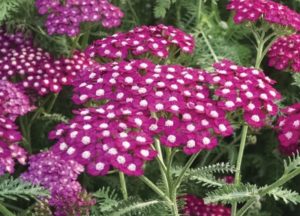
Achillea m. New Vintage Violet
Grows in zones 4 to 9
Full Sun
As New Vintage Violet mtures, it reaches 12 to 14 inches tall
Fragrantly scented, deep violet flower clusters bloom from Summer into early Fall
Attracts pollinators such as bees and butterflies
Resistant to both deer and rabbits
Use flowers in cut and dried floral bouquets
Prefers well-draining soil conditions
Plant in containers
Tolerant of drought conditions, once established
-
Agastache
There are several common names for Agastache. However, the most common name is Hummingbird Mint, but is also called Anise Hyssop, and Hyssop Plants. Incredibly attractive to hummingbirds, the Hyssop flowers are also attractive to butterflies. While the goldfinches are frequent visitors for the seeds that follow the blooms.
Agastache Kudos Mandarin

Grows in zones 5 to 9
Full Sun
Closer to maturity, Kudos Mandarin reaches 17 to 22 inches tall
Fragrantly scented, Mandarin Orange flowers bloom in the Summer
Attracts pollinators such as bees, butterflies, and hummingbirds
Resistant to deer
Use flowers in cut and dried floral bouquets
Prefers well-draining soil conditions
Tolerant of drought conditions, once established
Agastache Blue Fortune

Native
Grows in zones 3 to 9
Full Sun
As Blue Fortune matures, it reaches 24 to 36 inches tall
Fragrantly scented, lavender blue flower spikes blooms in the Summer
Attracts pollinators such as bees, butterflies, and hummingbirds
Resistant to deer
Use flowers in cut and dried floral bouquets
Prefers well-draining soil conditions
Tolerant of drought conditions, once established
Agastache Morello

Native
Grows in zones 5 to 9
Full Sun
At maturity, Agastache Morello reaches 27 to 33 inches tall
Fragrantly scented, vivid ruby-pink flower stalks with bronzy green foliage bloom in the Summer
Attracts pollinators such as bees, butterflies, and hummingbirds
Resistant to deer
Use flowers in cut and dried floral bouquets
Prefers well-draining soil conditions
Tolerant of drought conditions, once established
-
Anagallis monellii Blue Pimpernel – Plants that are Drought Tolerant

Anagallis monellii Blue Pimpernel
Grows in zones 9 to 11
Full Sun
As it matures, Blue Pimpernel reaches 10 inches tall with a 20 inch spread
Blue purple gentian flowers with pink eye and yellow anthers blooms from early to late Summer – A True Blue flowering plant
Resistant to deer
Plant in containers and hanging baskets
Tolerates drought conditions once established
Easy Re-seeders – self-sows
-
Anthemis sancti-johannis St. John’s Chamomile
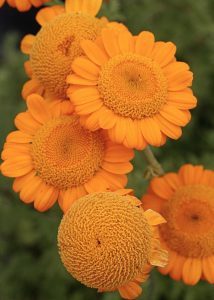
Anthemis sancti-johannis St. John’s Chamomile
Grows in zones 4 to 10
Full Sun
As it matures, St. John’s Chamomile tops out at 2 feet tall with a spread of 18 inches wide
Fragrantly scented, orange daisy flowers with fragrant ferny foliage blooms from early to late Summer
Bee friendly, attracts butterflies and wildlife
Resistant to deer
Use flowers in cut and dried floral bouquets
Plant in containers
Tolerates dry soil conditions
Tolerant of drought conditions once established
Low to average water needs
Easy Re-seeders – self-sows
- Baptisia – Plants that are Drought Tolerant
A common name is False Indigo. Baptisia has a lupine-like flower with blue green foliage. A Spring blooming perennial that matures to a shrub-sized plant. Blooms develop into black seed pods that are attractive. Baptisia takes about a year to establish.
American Goldfinch Baptisia

Native
Grows in zones 4 to 9
Part shade and part Sun to full Sun
As American Goldfinch matures, it reaches 36 to 40 inches tall
Bright yellow floral spires bloom in the Spring
Attracts butterflies, birds, and hummingbirds
Resistant to deer
Use flowers in cut and dried floral bouquets
Tolerant of drought conditions once established
Baptisia australis
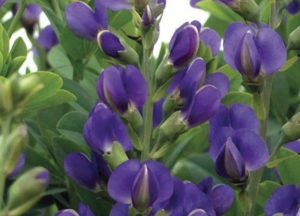
Native
Grows in zones 3 to 9
Part shade and part Sun to full Sun
At maturity, Baptisia australis reaches 48 inches tall
True indigo flower spikes over bushy mounds of blue green foliage that bloom in the Spring.
Beneficial for pollinators, attracts butterflies, birds, hummingbirds
Resistant to deer
Use flowers in cut and dried floral bouquets
Tolerant of drought conditions once established
Baptisia Decadence Vanilla Cream

Baptisia Decadence Vanilla Cream
Native
Grows in zones 4 to 9
Part shade and part Sun to full Sun
At maturity, Vanilla Cream reaches 30 to 36 inches tall
Barely yellow turning to cream 10 inch spikes with bronze foliage blooms in the Spring
Frequently visited by pollinators including butterflies, birds, hummingbirds
Resistant to deer
Use flowers in cut and dried floral bouquets
Tolerant of drought conditions once established
-
Bearded Iris
The Bearded Iris is also known as Iris germanica. A six-petal, hardy, long-lived perennial that is easy to maintain. Three upright petals referred to as standards with the three hanging petals known as falls. Finally, the line or beard runs down the middle of each fall.
Mango Entree Bearded Iris
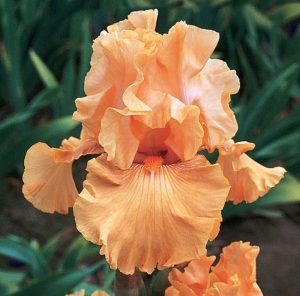
Grows in zones 4 to 9
Full Sun
As Mango Entree matures, it reaches 36 to 38 inches tall with a spread of 12 inches wide
Fragrantly scented, deep apricot-colored flowers with heavily-ruffled petals blooms in late Spring
Resistant to deer
Tolerates sandy and normal soil conditions
Tolerant of drought conditions once established, a Waterwise perennial
Immortality Re-blooming Bearded Iris

Immortality Re-blooming Bearded Iris
Grows in zones 3 to 9
Full Sun
At maturity, Immortality Re-blooming reaches 29 inches tall
Sweetly fragrant pure white flowers with yellow beards blooms from late Spring and again in early to mid Fall
Foliage is green, sword-shaped, linear leaves
Resistant to both deer and rabbits
Tolerates sandy and loamy soil conditions
Tolerant of drought conditions once established
-
Camissonia cheiranthifolia Beach Primrose
Beach Primrose
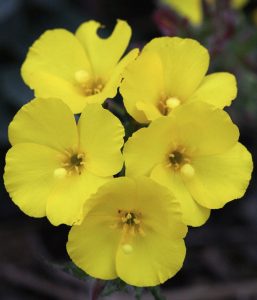
California coastal native
Grows in zones 8 to 10
Full Sun
Closer to maturity, Beach Primrose reaches 6 to 12 inches tall with a spread of 30 inches wide
Sunshine yellow flowers with silvery-green foliage bloom from April into September
Bee friendly, attracts wildlife
Plant in containers and hanging baskets
Use as a ground cover
Tolerates sandy and loamy soil conditions
Tolerant of drought conditions once established
-
Callirhoe digitata
Commonly known as Fringed Poppy Mallow and Standing Winecups. The Callirhoe plant is a wildflower native to the lower midWest and eastern Great Plains.
Fringed Poppy Mallow

Native to lower midWest and eastern Great Plains
Grows zones 3 to 8
Part shade and part Sun to full Sun
As Fringed Poppy Mallow matures, it reaches 36 inches tall with a spread of 12 to 15 inches wide
Magenta-pink flowers bloom from early to late Summer
Bee friendly
Resistant to rabbits
Tolerant of sandy, clay, and average soil conditions
Tolerates drought conditions once established, a Waterwise perennial
9. Catananche caerulea Cupid’s Dart
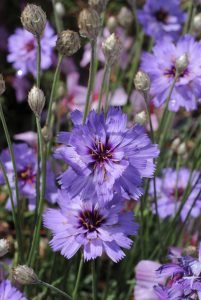
Catananche caerulea Cupid’s Dart
Grows in zones 4 to 10
Full Sun
At maturity, Cupid’s Dart reaches 2 feet tall with a spread of 20 inches across
Semi-double Lavender blue purple-eyed blooms in the Summer months
Attracts butterflies
Resistant to deer
Tolerant of drought conditions once established
Low to average water needs
Easy Re-seeders – self-sows
10. Centaurea – Plants that are Drought Tolerant
Known by these names – Perennial Bachelor’s Button, Mountain Bluet, Cornflower, and Basket Flower. An exceptionally easy perennial to grow, the Centaurea has unusual buds that open with fringed, thistle-like blooms.
Centaurea Montana

Grows in zones 3 to 8
Mostly Sunny to full Sun
Closer to maturity, Centaurea Montana tops out at 2 feet tall
Violet-blue purple flower with spidery deeply fringed petals bloom in late Spring with re-bloom in early Fall Centaurea
Beneficial for Pollinators
Good for cut flowers
Tolerant of hot dry site
11. Convolvulus sabatius Ground Morning Glory

Grows in zones 7 to 9
Part shade and part Sun to full Sun
At maturity, Morning Glory reaches about 10 inches tall with a spread of 36 inches across
With it bluish-purple funnel-shaped flowers that bloom from late Spring until Fall, it attracts butterflies
Resistant to deer, gopher, slug, and snail
Tolerates clay soil conditions
Tolerant of hot, dry site, and drought conditions once established
Plant in containers, hanging baskets
Use as a evergreen ground cover which helps prevent soil erosion
Low water needs
12. Coreopsis – Plants that are Drought Tolerant
Common names of Coreopsis are Butter Daisy and Tickseed. Great blooms for cut flowers. Attracts butterflies and birds. Coreopsis will easily naturalize.
Coreopsis Jethro Tull
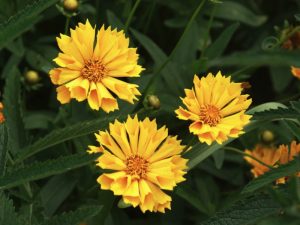
Grows in zones 4 to 9
Full Sun
As Jethro Tull matures, it reaches 15 to 18 inches tall
Brightly colored yellow fluted petal flowers blooms from early Summer to early Fall
Frequently visited by pollinators that includes butterflies
Resistant to deer
Tolerates of sandy and normal soil conditions
Tolerant of humidity and hot dry site conditions
Use flowers in cut bouquets
Plant in containers
Coreopsis grandiflora Sunfire
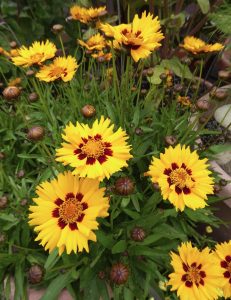
Grows in zones 4 to 9
Part shade and part Sun to full Sun
As it matures, Sunfire Coreopsis reaches 20 inches tall and wide
Vividly colored yellow flowers with dark red dot on each petal blooms early Summer into Fall
Attracts butterflies, birds, and wildlife
Resistant to deer
Fire Resistant
Plant in containers
Use flowers in cut floral bouquets
Tolerates hot dry, hot humid, clay soil conditions
Tolerant of drought conditions once established
Low to average water needs
13. Dalea purpurea – Plants that are Drought Tolerant
Common name is Prairie Clover. From the plains and prairies, initially documented by Meriwether Lewis in late July 1804. His first sighting of the Purple Prairie Clover.
Dalea p. Stephanie

Native
Grows in zones 3 to 9
Full Sun
As it matures, Stephanie reaches 18 to 30 inches tall
Sporting a lavender ballerina’s tutus Stephanie blooms in the Summer
Beneficial for pollinators, attracts bees, butterflies
Resistant to deer
Tolerant of drought conditions once established, a Waterwise perennial
14. Dianthus
Also known as Pinks, are garden classics. Most have blue green or blue frosted quill-like foliage. Many are fragrant and make cute bouquets. Plants are low maintenance and tolerant of heat conditions.
Fruit Punch Cranberry Cocktail Pinks
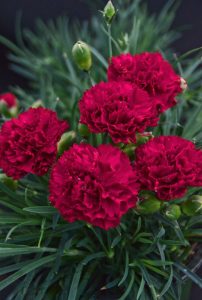
Grows in zones 4 to 9
Part shade and part Sun to full Sun
As Cranberry Cocktail matures, it reaches 8 to 10 inches tall with a spread of 12 to 14 inches wide
Fragrantly scented, hot Magenta flowers with blue green foliage in grey-green shades bloom early Summer and early Fall
Bee Friendly and attracts butterflies
Resistant to deer
Tolerant of heat, salt, and drought conditions once established
Provides Winter interest to the garden
Dianthus Scent First Coconut Surprise
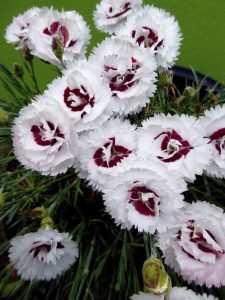
Dianthus Scent First Coconut Surprise
Grows in zones 5 to 10
Full Sun
Reaches 10 inches tall and wide
Fragrant vivid blood-red centers with black and white flowers that bloom from Spring thru Summer
Attracts butterflies
Resistant to deer
Fire Resistant
Plant in containers
Use flowers in cut bouquets
Tolerant of drought conditions once established
Use as an evergreen ground covers
15. Echinacea – Plants that are Drought Tolerant
The common name of Echinacea is Coneflower. Provides Summer color to the garden. Beneficial for butterflies and birds. Use in floral arrangements and bouquets.
Mellow Yellows Echinacea
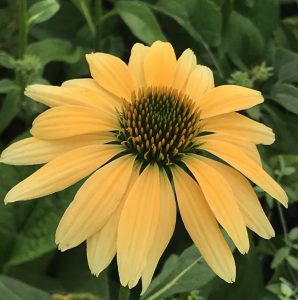
Native
Grows in zones 4 to 8
Part Sun and part shade to full Sun
At maturity, Mellow Yellows reaches 24 to 30 inches tall with a spread of 12 to 24 inches wide
Cream to apricot to canary yellow flowers bloom from early Summer to mid Fall
Bee Friendly perennial that attracts butterflies, birds
Resistant to deer
Use in floral bouquets
Tolerates of sandy, clay, average, or compost enriched Garden Loam soil conditions
Tolerant of drought weather conditions once established
Provides Winter interest to the garden as well as seeds for Winter birds
Companion plants for Echinacea are Ornamental Grasses, Lavender, Agastache (Hummingbird Mint), and Monarda (Bee Balm)
PowWow Wild Berry Coneflower
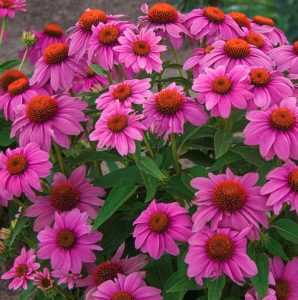
Grows in zones 3 to 9
Part shade and part Sun to full Sun
Closer to maturity, PowWow Wild Berry reaches 24 to 36 inches tall with a spread of 12 to 18 inches wide
Deeply colored pink flowers bloom from midSummer to early Fall
Beneficial for pollinators, attracts birds, butterflies
Tolerant of acidic, clay, loamy, sandy and dry soil conditions
Tolerant of drought weather conditions once established
Echinacea Rainbow Marcella
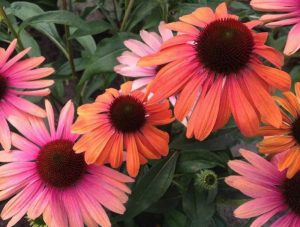
Grows in zones 4 to 9
Mostly Sunny to full Sun
Closer to maturity, Rainbow Marcella reaches 15 to 18 inches tall
Raspberry pink flowers with muted orange to golden yellow tips blooms from early Summer to early Fall
Beneficial for pollinators, attracts butterflies
Resistant to deer
Plant in containers
Use in floral bouquets
Tolerant of clay and normal soil conditions.
Tolerates hot dry site, humidity, and drought weather conditions once established
Provides Winter interest to the garden
16. Gaillardia – Plants that are Drought Tolerant
Common Name of Gaillardia is Blanket Flower.
Gaillardia g. Mesa Red
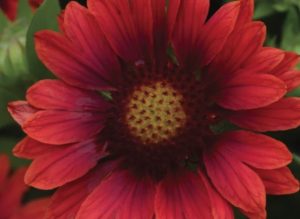
Native
Grows in zones 4 to 9
Full Sun
At maturity, Mesa Red reaches 18 to 20 inches tall
Deep red flowers that bloom in the Summer and into the Fall
Extremely beneficial for pollinators that includes bees, butterflies, birds
Resistant to deer
Use in floral and dried bouquets
Plant in containers
Tolerant of heat and drought weather conditions once established
Gaillardia Mesa Peach

Native
Grows in zones 5 to 9
Full Sun
Closer to maturity, Mesa Peach reaches 16 to 18 inches tall with a spread of 20 to 22 inches wide
Peachy-golden flowers bloom from late Spring to late Summer
Attract Butterflies
Resistant to deer and rabbits
Use in floral bouquets
Plant in containers, rock gardens, and alpine gardens
Tolerates sandy soil conditions
Tolerant of hot dry and drought conditions, a Waterwise perennial
Plants For Small Spaces
17. Geranium
Geranium pyrenaicum Bill Wallis

Grows in zones 5 to 10a
Part shade and part Sun to full Sun
At maturity, Bill Wallis tops out at 15 inches high by 20 inches wide dry shade
Deeply colored purple blue heart shaped petal flowers bloom Spring into the Fall season
Bee friendly, attracts butterflies and wildlife
Resistant to deer, gopher
Tolerates clay soil conditions
Tolerant of shade, hot dry, hot humid, dry shade and drought conditions
Plant in containers and hanging baskets
Use as a ground covers
Under Oaks
Low to average water needs
Easy Re-seeders
18. Heliopsis
Also called the False Sunflower, Heliopsis are long blooming perennials.
Heliopsis helianthoides Asahi
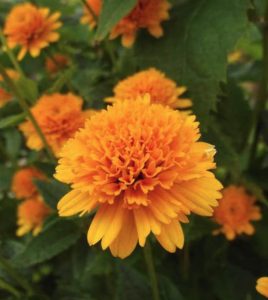
Grows in zones 3 to 9
Mostly Sunny to full Sun
Once Asahi matures, it reaches 22 to 24 inches tall
Golden yellow double flowers bloom from late Spring to early Fall
Beneficial for Pollinators, attracts Butterflies
Use in floral bouquets
Tolerant of clay and normal soil conditions
Tolerant of humidity, hot dry site, and drought conditions once established
Companion plants for Asahi are Joe Pye Weed, Purple Coneflower, Salvia and either bright orange or yellow Gaillardia
Note: Asahi means morning sun in Japanese
Tuscan Sun Perennial Sunflower

Tuscan Sun Perennial Sunflower
Native
Grows in zones 3 to 9
Full Sun
As it matures, Tuscan Sun Sunflower reaches 24 to 36 inches tall with a spread of 20 to 24 inches wide
Brightly colored yellow to Golden Yellow blooms from mid to late Summer
Bee friendly, attracts butterflies
Use in floral bouquets
Plant as a border garden, specimen, or as a focal point in the garden
Tolerant of acidic soils
Tolerant of heat and drought conditions once established
19. Hemerocallis
Also called a daylily. Quick to establish and require little care afterwards. Day lilies are tolerant of juglone which is found in the soil around Black Walnut trees.
Hemerocallis Cosmopolitan

Grow in zones 3 to 9
Mostly to full Sun
At maturity, Cosmopolitan stands 18 inches tall
Rich rose pink blooms with pink accent blooms from early to Mid-Summer
Attracts butterflies, hummingbirds
Resistant to rabbits
Plant in containers
Tolerates of clay, acidic, and normal soil conditions.
Tolerant of hot dry sites, seaside salt, and drought weather conditions once established
Companion plants for Cosmopolitan, a diploid are Stella D’Oro Hemerocallis
Hemerocallis Siloam Double Classic
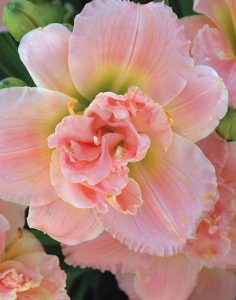
Siloam Double Classic Hemerocallis
Grows in zones 3 to 9
Mostly Sunny to full Sun
At maturity, Siloam Double Classic tops out at 16 inches high
Sweetly fragrant peach with yellow halo and green throat flowers bloom from late June to early July
Attracts butterflies, hummingbirds
Resistant to rabbits
Plant in containers
Tolerates clay, acidic, and normal soil conditions
Tolerant of hot dry sites, seaside salt, and drought weather conditions once established
Hemerocallis On and On
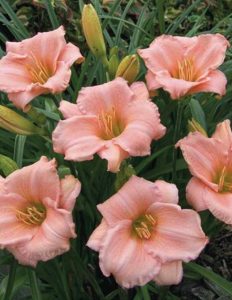
Grows in zones 3 to 9
Mostly Sunny to full Sun
As On and on Hemerocallis, reaches 14 to 18 inches tall
Fragrantly scented, the pastel pink flowers with pink accents bloom from early Summer to early Fall
Attracts butterflies, hummingbirds
Resistant to rabbits
Plant in containers
Tolerant of clay, acidic, and normal soil conditions
Tolerates hot dry site, seaside salt, and drought weather conditions once established
20. Lavender – Plants that are Drought Tolerant
From the herb family, Lavandula is used for perfumes and potpourri. An ornamental fragrant plant with a compact habit that is drought tolerant.
Purple Ribbon Spanish Lavender
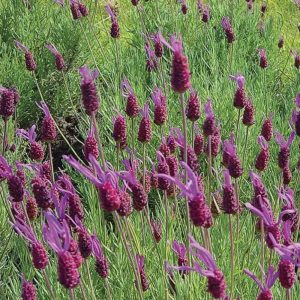
Purple Ribbon Spanish Lavender
Grows in zones 7 to 10
Full Sun
At maturity, Purple Ribbon reaches 14 to 16 inches tall with a spread of 15-18 inches wide
Fragrant dark purple flower spikes with dark purple bracts or wings on top of spikes blooms in Summer flowers
Bee Friendly, attract butterflies
Resistant to deer and rabbits
Use flowers in cut and dried floral bouquets
Plant in containers
Use in rock gardens or alpine plant
Tolerant of drought conditions once established, a Waterwise perennial
Mitcham Gray English Lavender

Grows in zones 5 to 10
Full Sun
At full maturity, Mitcha Gray reaches 24 inches tall with a spread of 24 to 28 inches wide
Fragrantly scented blooms of deep violet-blue, the floral spikes with gray-green foliage blooms in the Summer
Bee Friendly, attract butterflies
Both deer and rabbit resistant
Use flowers in cut and dried floral bouquets
Use in rock gardens or alpine plant
Tolerant of drought conditions once established, a Waterwise perennial
Phenomenal Lavender
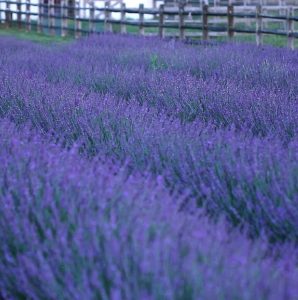
Grows in zones 5 to 9
Full Sun
Reaches 30 to 32 inches tall with a spread of 24 to 32 inches wide
Fragrant purple flowers on tall stems blooms from mid-Summer to early Fall
Bee Friendly, attract butterflies
Resistant to deer
Use flowers in cut and dried floral bouquets
Plant in containers
Tolerates sandy, average, and dry soil conditions
Tolerant to heat, high humidity, and drought weather conditions once established, a Waterwise
21. Lewisia
With the many common names used for Lewisia, it is known as bitterroot, cliff maids, and Siskiyou Lewisia. A succulent with fleshy leaves that emerge in flat rosettes of spoon shaped leaves. Spring blooming flowers are funnel-shaped about 1 inch wide. Perfect for rock gardens, incredibly tolerant of drought conditions.
Lewisia Constant Fuchsia

Grows in zones 4 to 8
Full Sun
Reaches 4 inches tall
Fuchsia colored flowers bloom from Spring to Fall
Beneficial for pollinators, attracts butterflies, hummingbirds
Resistant to deer
Plant in containers
Tolerant of drought conditions once established
Lewisia Constant Coral

Grows in zones 4 to 8
Full Sun
As Constant Coral matures, it reaches 4 inches tall
Continuously blooming, coral colored flowers bloom from Spring to Fall
Beneficial for pollinators, attracts butterflies, hummingbirds
Resistant to deer
Plant in containers
Tolerant of drought conditions once established
Lewisia cotyledon Sunset Strain

Sunset Strain Lewisia cotyledon
California Native
Grows in zones 4 to 10
Full Sun
At maturity, Sunset Strain reaches about 6 inches tall
Sunset colors of apricot pink, soft tangerines, and soft yellow floral clusters bloom from May to September
Resistant to deer
Fire Resistant
Plant in containers
Tolerant of drought conditions once established
Succulent with low to average water needs
22. Liatris – Plants that are Drought Tolerant
Commonly known as Blazing Star or Gayfeather. Liatris is a Summer blooming perennial with bottle-brush flowers. A North American wildflower with floral spikes loved by butterflies, reaching 2 to 4 feet tall.
Dotted Blazing Star or Liatris

Native to Great Plains and Colorado, New Mexico
Grows in zones 4 to 9
Full Sun
Reaches 12-18 inches tall with a spread of 8 to 12 wide
Lavender-pink flower spikes bloom from late Summer to Fall
Bee Friendly, attract butterflies, birds, hummingbirds
Resistant to deer and rabbits
Use flowers in cut floral bouquets
Tolerant of sandy, clay, and average soil conditions
Tolerates drought weather conditions, a Waterwise plant – the most drought tolerant of the genus
Texas Blazing Star, Liatris
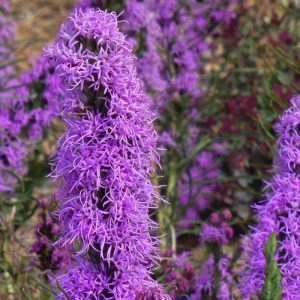
Native of the south-central areas such as Texas, Oklahoma, and southern Great Plains
Grows in zones 5 to 9
Full Sun
Reaches 24 to 30 inches tall with an 18 inch spread
Lavender-pink blooms from late Summer to Fall
Beneficial for pollinators, attracts butterflies, birds for the seeds
Resistant to deer
Tolerant of hot dry sites, humidity, and drought weather conditions once established, a Waterwise perennial
Blazing Star

Native
Grows in zones 3 to 9
Part shade and part Sun to full Sun
As Blazing Star matures, it reaches 24 to 48 inches tall by 12 to 24 inches wide
Purple spiky blooms from mid to late Summer
Bee Friendly, attracts butterflies, birds, and hummingbirds
Resistant to deer
Use flowers in cut floral bouquets
Tolerant of sandy, loamy, and dry soil conditions
Tolerates humidity, dry site and drought conditions once established
Companion plants for Blazing Star are bee balm and black eyed Susan
23. Linaria purpurea Toadflax

Grows in zones 5 to 10
Part shade and part Sun to full sun
As Toadflax reaches maturity, it stands 3 feet tall by 1 foot wide
Tiny violet-blue snapdragon-like spike flowers bloom in the Summer
Bee friendly, attracts butterflies, wild life
Resistant to deer
Use flowers in cut floral bouquets
Tolerates clay soil conditions
Tolerant of drought conditions once established
Low to average water requirements
Easy Re-seeders
24. Munro’s Globe Mallow

Native to the great basin of western US
Grows in zones 4 to 9
Full Sun
At maturity, Munro’s Globe Mallow reaches 36 to 42 inches tall with a spread of 24 inches wide
Brightly colored orange flowers bloom from mid to late Summer
Bee Friendly
Resistant to deer and rabbits
Use in a rock garden, as an alpine plant, or small space garden
Namely tolerant of clay, poor, and well-draining soil conditions
Tolerant of very drought conditions once established, a Waterwise perennial
Ideal for Southwest and Western garden areas
25. Mangave – Plants that are Drought Tolerant
Through an intergeneric cross between Manfreda and Agave plants, Mangave plants came to life. An extraordinary combination of two worlds. With an improved growth rate and exceptional foliage patterns from the Manfreda plant, Mangave is a standout. And equally important are the attributes of the Agave plant line of a better growth habit and the plant’s refinement. A new hybrid from the talented team at Walters Gardens.
As a comparison, the Mangave plant is to the full Sun garden what a hosta is to a full shade garden. Although, hosta plants do bloom whereas some Mangave plants bloom. Both plants are invaluable for their stunning foliage colors and patterns. And both types of plants bring strong garden interest to an otherwise lackluster garden. For more information about Mangave read our post Mangave Plants for Sunny gardens.
Silver Fox Mangave
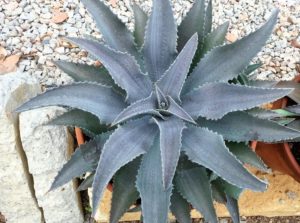
Grows in about zones 9a to 11
Part shade and part Sun to full Sun
As Silver Fox Mangave matures, it reaches 11 inches high with a spread of 22 inches wide
At times, yellow blooms with foliage colors of shades of silvery green with a light blue-purple spotty underneath
Resistant to both deer and rabbits
Tolerant of poor, average, slightly acidic, slightly alkaline, and neutral soil conditions
Drought tolerant once the plant has been established
Low to average water needs
Growth rate is slow
Thunderbird Mangave
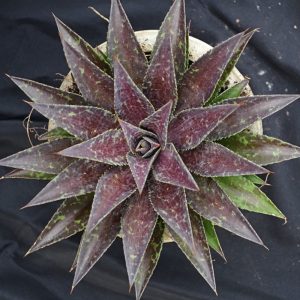
Grows in about zones 9a to 11
Part shade and part Sun to full Sun
Reaches 8 inches high with a spread of 12 inches wide
Reddish-violet leaf spotting is dense on the foliage
Resistant to both deer and rabbits
Tolerant of poor, average, slightly acidic, slightly alkaline, and neutral soil conditions
Drought tolerant once the plant has been established
Painted Desert Mangave
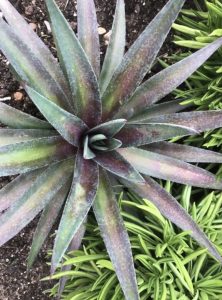
Grows in about zones 9a to 11
Part shade and part Sun to full Sun
Reaches 12 inches high with a spread of 24 inches wide
Olive green foliage with heavily spotted purple and muted gold central band
Resistant to both deer and rabbits
Tolerant of poor, average, slightly acidic, slightly alkaline, and neutral soil conditions
Drought tolerant once the plant has been established
Brought to life by plant breeder Hans Hansen
26. Melampodium leucanthum
More commonly known as a Blackfoot Daisy, the Melampodium leucanthum is native to the Southwestern U.S. Blackfoot Daisy is an ever-blooming wildflower native.
Blackfoot Daisy

Native
Grows in zones 5 to 10
Full Sun
As it matures, the Blackfoot Daisy reaches 10 to 12 inches tall by 12 to 20 inches wide
Fragrant white petals with yellow center flowers and foliage blooms in the Summer
Bee Friendly and attract butterflies and birds
Resistant to deer and rabbits
Use in rock gardens or as an alpine plant
Tolerates sandy soil conditions with gravel mulch however, dislikes clay soil
Tolerant of drought conditions once established, a Waterwise
perennial – easily adapts to arid climates
Companion plant for Blackfoot Daisy use with Penstemon
Ideal for Southwestern and Western garden areas
27. Nepeta – Plants that are Drought Tolerant
More frequently known as Catmint, Nepeta is long blooming and stunning. Perfectly suited for rock gardens, containers and garden borders. Best of all, resistant to both deer and rabbits.
Nepeta Cat’s Pajamas

Grows in zones 3 to 8
Mostly Sunny to full Sun garden areas
Reaches 12 to 14 inches tall
Lavender blue flowers followed by rosy purple calyxes blooms from late Spring to late Summer
Beneficial for pollinators, attracts butterflies, hummingbirds
Resistant to both deer and rabbits
Plant on a slope or bank
Tolerates sandy and normal soil conditions
Tolerant of hot dry sites, seaside salt, and drought weather conditions once established
Nepeta Walker’s Low

Grows in zones 3 to 8
Mostly Sunny to full Sun
Reaches 30 inches tall
Blue violet flowers with aromatic grey green foliage blooms from early to late Summer
Beneficial for pollinators, attracts butterflies, hummingbirds
Resistant to both deer and rabbits
Plant on a slope or bank
Tolerant of sandy and normal soil conditions
Tolerant of hot dry sites, seaside salt, and drought weather conditions once established
Companion plants to Walker’s Low are Coreopsis and Hemerocallis
Select Blue Catmint
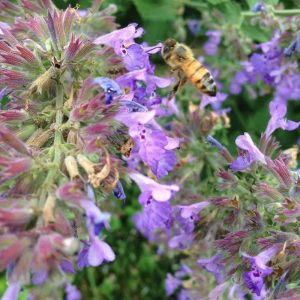
Grows in zones 4 to 9
Full Sun
Reaches 15 inches tall by 18 inches wide
Fragrant lavender-blue flowers with gray-green foliage bloom from late Spring and again in late Summer
Bee friendly, attract butterflies
Resistant to deer and rabbits
Plant in containers
Use in rock gardens or as an alpine plant
Tolerates average, sandy, low fertility, and well-draining soil conditions
Tolerant of drought conditions once established, a Waterwise
28. Papaver atlanticum Flore Pleno
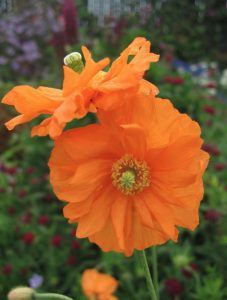
Papaver atlanticum Flore Pleno Moroccan Poppy
Grows in zones 5 to 10
Part shade and part Sun to full Sun
Reaches 30 inches tall
Apricot-orange semi-double flowers bloom in Spring thru Fall
Bee friendly
Resistant to deer
Tolerant of hot dry and drought weather conditions once established
Low to average water needs
Easy Re-seeders
29. Penstemon
Commonly known as Beardtongue, Penstemon thrives under Sun and heat. Mostly resistant to rabbits and attracts hummingbirds. Dislikes clay soil conditions.
Midnight Masquerade Beardtongue

Midnight Masquerade Beardtongue
Native to North America
Grows in zones 3 to 8
Full Sun
Reaches 36 to 40 inches tall with a spread of 28 to 32 inches tall
Lavender purple with pure white interiors with deep eggplant burgundy purple foliage blooms in early to mid Summer
Bee friendly attracts hummingbirds
Use flowers in floral bouquets
Foliage Interest
Tolerant of salt and drought conditions once established
Palmer’s Penstemon

Native to New Mexico and Arizona
Grows in zones 4 to 9
Full Sun
At maturity, Palmer’s Penstemon reaches 4 to 5 feet tall by 24 inches wide
Attract Hummingbirds
Resistant to both deer and rabbits
Fragrant light pink floral spikes with gray foliage blooms in early Summer
Grow in sandy, gravel soils, dislikes non-draining soils such as clay
Tolerant of heat and drought conditions once established, a Waterwise perennial
Coconino County Desert Penstemon
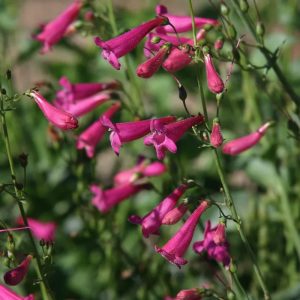
Coconino County Desert Penstemon
Native
Grows in zones 5 to 9
Full Sun
Reaches 30 to 36 inches tall with an 18 inch spread
Intensely deep-pink, tubular floral spikes blooms from late Spring to early Summer
Bee Friendly, attract butterflies, birds, hummingbirds
Resistant to deer
Plant in containers
Use in rock gardens or as an alpine plant
Tolerant of hot dry sites and drought conditions once established
Easy re-seeder to populate harsh garden sites
Companion plants for Desert Penstemon are Blue Flax and Chocolate Flower
30. Perovskia atriplicifolia
Commonly known as Russian sage, Perovskia atriplicifolia is a woody-based perennial of the mint family. Uniquely fragrant gray-green fine foliage on branches that reach between 2 to 4 feet tall. Strikingly beautiful panicle blooms of purple blue floral spikes appear over the Summer months.
Lacey Blue Russian Sage
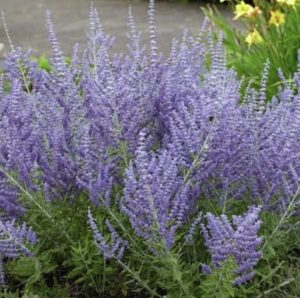
Grows in zones 5 to 9
Full Sun
Reaches 18 to 24 inches tall and wide
Fragrant lavender-blue flower spikes and silvery gray-green foliage from midSummer into Fall
Bee Friendly, attracts butterflies, hummingbirds
Resistant to both deer and rabbits
Use flowers in cut and dried floral bouquets
Tolerant of sandy, loamy, and dry soil conditions
Tolerates salt, humidity, hot dry site, and drought conditions once established
Blue Jean Baby Russian Sage

Grows in zones 4 to 9
Full Sun
At maturity, Blue Jean Baby reaches 28 to 34 tall with a spread of 36 inches
Bee friendly, attracts butterflies and hummingbirds
Resistant to deer and rabbits
Fragrantly scented, lavender-blue floral spires with gray-green foliage from mid Summer to mid Fall
Use flowers in floral bouquets
Plant in containers
Tolerant of average and dry soil conditions
Tolerates salt, hot dry site, and drought weather conditions once established
31. Phlox – Plants that are Drought Tolerant
Commonly named garden phlox, this perennial brings mid summer color to the garden. On tall columns of flower, phlox establishes well under full Sun. With its vanilla-clove fragrance, Phlox is a classic garden favorite. Of the many Phlox varieties they are deer resistant as well as mildew resistant.
A low-growing ground cover phlox, Creeping Phlox spreads like a carpet. Not only does Phlox grow in poor and rocky soil conditions, it also bring bright colorful flowers to soften the edges of rocks. Spring blooming Creeping Phlox tolerates drought conditions once it reaches maturity. And is deer resistant as well as mildew resistant.
Phlox paniculata, Cover Girl

Grows in zones 3 to 8
Full Sun
As it matures, Cover Girl reaches 38 to 42 inches tall with a spread of 24 to 28
Purple pastel shades bloom over the Summer
Tolerant of heat, humidity, and drought weather conditions once established
Scarlet Flame Creeping Phlox

Native
Grows in zones 3 to 9
Full Sun
At maturity, Scarlet Flame reaches 4 to 6 inches tall with a spread of 12 to 24 inches wide
Brilliantly colored flowers in magenta pink pop over a dense mat of needle-like foliage blooms from mid to late Spring
Attract butterflies
Resistant to deer
Evergreen ground cover for use in rock gardens or as an alpine plant
For a splash of color, plant on slopes, banks, rock walls
Tolerant of sandy and loamy soil conditions
Tolerant of cold, dry site, and drought weather conditions once established
32. Rudbeckia fulgida
More widely known as an orange coneflower, Rudbeckia fulgida is a native of the Southeast US. Grown in zone 3 to 9 reaching between 2 to 3 feet tall. And 2 to 2 ½ feet wide. Especially bright orange to yellow flowers bloom from June through October. A point often overlooked, is that later blooming perennials offer seeds for the seed eating birds in the Fall. Just as food supplies begin to diminish in the Fall, Rudbeckia seeds are always a welcome sight.
Goldsturm Black Eyed Susan

Native
Grows in zones 3 to 9
Part shade and part Sun to full Sun
Reaches 24 to 36 inches tall by 18 to 24 inches wide
Golden yellow, daisy-like petals surround brown center button flower that blooms from mid-Summer to early Fall
Attract Bee Friendly, attracts birds and butterflies
Resistant to both deer and rabbits
Use flowers in cut floral bouquets
Plant in containers
Tolerates of sandy, loamy, clay, acidic, and poor soil conditions
Tolerant of humidity, drought and dry soil conditions once established
Little Goldstar Black Eyed Susan
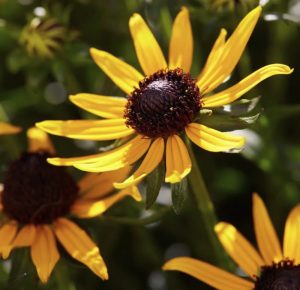
Little Goldstar Black Eyed Susan
Native
Grows in zones 4 to 10
Full Sun
Reaches 14 to 16 inches tall and wide
Golden yellow daisy like flowers blooms from mid Summer to early Fall
Bee Friendly, attracts butterflies, birds, hummingbirds
Resistant to deer
Use flowers in cut and dried floral bouquets
Plant in containers
Tolerates sandy, acidic, loamy and dry soil conditions
Tolerant of heat, humidity, and drought weather conditions once established
33. Rudbeckia hirta – Plants that are Drought Tolerant
Often referred to as Black Eyed Susan, Rudbeckia hirta is a biennial or short-lived perennial in some zones. As you may know, Hirta means hairy which describes the short bristles covering the plant leaves and stems. Pollinators love Rudbeckia plants.
Rudbeckia hirta Chim Chiminee

Grows in zones 5 to 10
Part shade and part Sun to full Sun
Reaches 30 inches tall
Sunny yellow to ruby red plus bicolors bloom from July until frost
Bee friendly, attracts butterflies, wildlife
Resistant to deer
Fire Resistant
Use flowers in cut floral bouquets
Plant in containers
Tolerates clay soil conditions
Tolerant of humidity, hot dry sites, and drought conditions once established
Average water needs
Easy Re-seeders
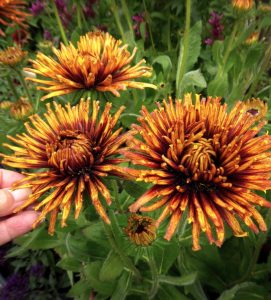
Note: Chim Chiminee have a variety of flowers both single and semi-double quilled petals as well as multiple colors. Flowers have a large central disc that forms large 6 inch blooms. All in a striking range of colors.
34. Santolina
Lavender Cotton Santolina are pleasantly aromatic. Nicely button-shaped flowers appear in the Summer months. Drought tolerant once established, loves full Sun and good drainage.
Santolina Ericoides
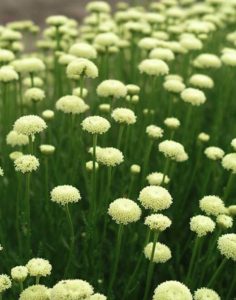
Grows in zones 5 to 9
Full Sun
Reaches 12 inches tall
Fragrant lemon-yellow drop flowers bloom from early to late Summer
Attracts Butterflies
Resistant to deer
Tolerates poor, sandy, and normal soil conditions
Tolerant of heat, hot dry sites, and drought conditions once established
35. Salvia
Widely known as Sage, the Salvia plant is part of the mint family of plants. Sage does best in full sun and loves the heat. Loved by butterflies but deer tend to stay away from Salvia.
Cold Hardy Pink Texas Salvia
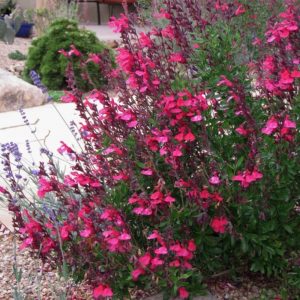
Native
Grows in zone 6 to 10
Full Sun
Reaches 18 to 20 inches tall with a spread of 18 to 24 inches wide
Deep pink flowers bloom from late Spring to early Fall
Bee friendly, attracts hummingbirds
Resistant to deer and rabbits
Javelina resistant
Tolerant of sandy and average soil conditions.
Tolerates drought conditions, a Waterwise
Good For Containers
May Night Salvia
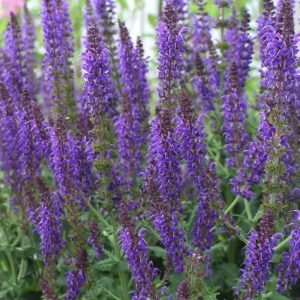
Grows in zones 4 to 9
Full Sun
Reaches 15 to 18 inches tall with a spread of 18 inches wide
Fragrant deep purple-blue floral spikes bloom from late Spring to late Summer
Bee Friendly, attract butterflies, birds, hummingbirds
Resistant to both deer and rabbits
Use flowers in cut floral bouquets
Plant in containers
Tolerates sandy, clay, and average soil conditions
Tolerant of drought conditions once established, a Waterwise perennial
Salvia n. Sensation Deep Rose
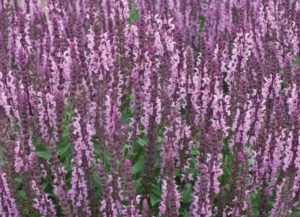
Grows in zones 3 to 8
Full Sun
Reaches 14 inches tall
Pink floral spikes over purple stems bloom in early Summer
Plant in containers, garden borders
Salvia n. Caradonna
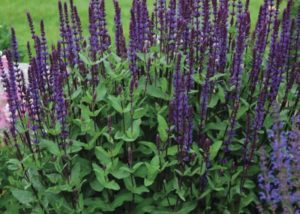
Grows in zones 3 to 8
Full Sun
Reaches 24 to 30 inches tall
Fragrant dark purple floral spikes bloom in early Summer
Bee friendly, attracts pollinators, birds, butterflies, hummingbirds
Resistant to both deer and rabbits
Use flowers in cut and dry floral bouquets
Plant in containers, garden borders
Tolerant of drought conditions once established
36. Sedum – Plants that are Drought Tolerant
Commonly known as Stonecrop, Sedum grows in a wide range of sizes, colors, and shapes. Adaptable sedum blooms in late Summer into Fall. They produce heads full of nectar in rose, red, yellow, or white flowers. Attracts butterflies and hummingbirds. Foliage is fleshy bright green, gray, red, maroon, chartreuse, or variegated from early Spring until frost. Resistant to deer and rabbits. Hardy from zones 3 to 8 with low water needs.
Sedum Frosty Morn
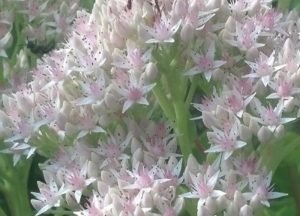
Grows in zones 3 to 8
Full Sun
At maturity, Frosty Morn reaches 24 inches tall
Clusters of white to pink flowers bloom from late Summer into Fall
Bee friendly, attracts birds, butterflies
Resistant to rabbits
Use flowers in cut and dry floral bouquets
Plant in containers
Tolerant of drought conditions once established
Sedum Mr. Goodbud
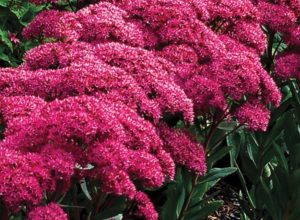
Grows in zones 4 to 9
Full Sun
Reaches 15 inches tall
Clusters of lighter pink buds which open to vibrant purple-pink flowers bloom in late Summer
Bee friendly, attracts birds, butterflies
Resistant to rabbits
Use flowers in cut and dry floral bouquets
Plant in containers
Tolerant of drought conditions once established
Provides Winter interest in the garden
Sedum sieboldii

Grows in zones 4 to 8
Full Sun
As it matures, Sedum sieboldii reaches 8 inches tall
Pink flowers bloom late Summer
Bee friendly, attracts birds, butterflies
Resistant to rabbits
Use flowers in cut and dry floral bouquets
Plant in containers
Tolerant of drought conditions once established
37. Verbascum
Verbascum phoeniceum Violetta

Grows in zones 4 to 10
Part shade and part Sun to full Sun
As Violetta Verbascum mtures, it reaches 30 inches tall
Dark violet-purple flowers bloom in the Summer
Bee friendly, attracts wildlife
Resistant to deer and snail
Use flowers in cut floral bouquets
Tolerates clay soil conditions
Tolerant of shade, dry shade, and drought weather conditions once established
Low to average water needs
Easy Re-seeders
38. Verbena – Plants that are Drought Tolerant
Valley Lavender Plains Verbena
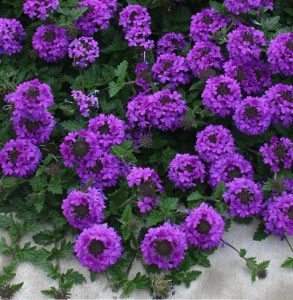
Valley Lavender Plains Verbena
Native of Great Plains
Grows in zones 5 to 8
Full Sun
Once it matures, Valley Lavender reaches 3 to 6 inches tall with a spread of 12 to 18 inches wide
Fragrantly scented, the brightly colored purple flowers bloom from late Spring to mid Fall
Attract butterflies
Plant as a ground cover
Tolerates sandy, compost enriched, poor, and loamy soil conditions
Tolerant of drought conditions once established, a Waterwise perennial
Low water needs
Ideal for Southwest and Pacific garden areas
This ends our list of plants that are drought tolerant. There are numerous reasons that gardens aren’t watered routinely. Some of those reasons are lack of rainfall, watering restrictions, time, as well as money. In some extreme cases, lack of rainfall can lead to watering restrictions in communities. And in turn, water usage becomes either too costly for plant watering or the gardener risks being fined for plant watering. But of course, the exception to this rule is watering your vegetable gardens.
Frugal families choose to grow their own vegetables to save money. It is important to realize that frugal families also seek plants that require less watering and care. Selecting the right plants for the right garden goes a long way in saving money for the frugal family. So for this reason, choosing plants that are drought tolerant is the right garden solution. After all, these plants not only save time, money, but water as well.
Finally, all of us search for ways to live frugally and save money. Selecting plants that require less attention, care, and water is one more way to keep your home expenses low. We hope you enjoyed this post. And if you found this interesting, we know you’ll enjoy these …..
You will Enjoy some of our other gardening related posts.
How to Provide a Reliable Water Source for Birds
How to Create a Wildlife Sanctuary with Native Plants
Native Plants that Attract Birds
And if you have any gardening questions, feel free to reach out to us. We always are ready to help you out. Please include your zone and sunlight requirements with any garden related questions.
Thank you for dropping by.
Mary

